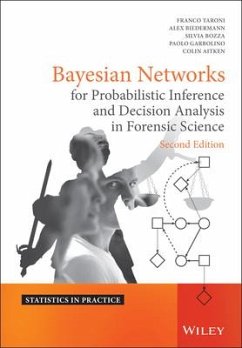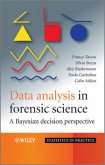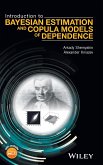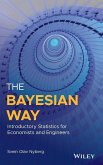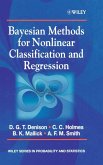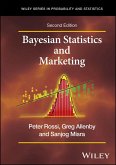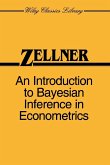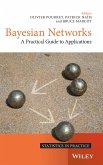Franco Taroni, Alex Biedermann, Silvia Bozza, Paolo Garbolino, Colin Aitken
Bayesian Networks Probabilisti
Franco Taroni, Alex Biedermann, Silvia Bozza, Paolo Garbolino, Colin Aitken
Bayesian Networks Probabilisti
- Gebundenes Buch
- Merkliste
- Auf die Merkliste
- Bewerten Bewerten
- Teilen
- Produkt teilen
- Produkterinnerung
- Produkterinnerung
"This book should have a place on the bookshelf of every forensic scientist who cares about the science of evidence interpretation." Dr. Ian Evett, Principal Forensic Services Ltd, London, UK Bayesian Networks for Probabilistic Inference and Decision Analysis in Forensic Science Second Edition Continuing developments in science and technology mean that the amounts of information forensic scientists are able to provide for criminal investigations is ever increasing. The commensurate increase in complexity creates diffculties for scientists and lawyers with regard to evaluation and…mehr
Andere Kunden interessierten sich auch für
![Data Analysis in Forensic Science Data Analysis in Forensic Science]() Franco TaroniData Analysis in Forensic Science113,99 €
Franco TaroniData Analysis in Forensic Science113,99 €![Introduction to Bayesian Estimation and Copula Models of Dependence Introduction to Bayesian Estimation and Copula Models of Dependence]() Arkady ShemyakinIntroduction to Bayesian Estimation and Copula Models of Dependence134,99 €
Arkady ShemyakinIntroduction to Bayesian Estimation and Copula Models of Dependence134,99 €![The Bayesian Way: Introductory Statistics for Economists and Engineers The Bayesian Way: Introductory Statistics for Economists and Engineers]() Svein Olav NybergThe Bayesian Way: Introductory Statistics for Economists and Engineers131,99 €
Svein Olav NybergThe Bayesian Way: Introductory Statistics for Economists and Engineers131,99 €![Bayesian Methods for Nonlinear Classification and Regression Bayesian Methods for Nonlinear Classification and Regression]() David G. T. DenisonBayesian Methods for Nonlinear Classification and Regression207,99 €
David G. T. DenisonBayesian Methods for Nonlinear Classification and Regression207,99 €![Bayesian Statistics and Marketing Bayesian Statistics and Marketing]() Peter E RossiBayesian Statistics and Marketing120,99 €
Peter E RossiBayesian Statistics and Marketing120,99 €![An Introduction to Bayesian Inference in Econometrics An Introduction to Bayesian Inference in Econometrics]() Arnold ZellnerAn Introduction to Bayesian Inference in Econometrics200,99 €
Arnold ZellnerAn Introduction to Bayesian Inference in Econometrics200,99 €![Bayesian Networks Bayesian Networks]() Bayesian Networks153,99 €
Bayesian Networks153,99 €-
-
-
"This book should have a place on the bookshelf of every forensic scientist who cares about the science of evidence interpretation." Dr. Ian Evett, Principal Forensic Services Ltd, London, UK Bayesian Networks for Probabilistic Inference and Decision Analysis in Forensic Science Second Edition Continuing developments in science and technology mean that the amounts of information forensic scientists are able to provide for criminal investigations is ever increasing. The commensurate increase in complexity creates diffculties for scientists and lawyers with regard to evaluation and interpretation, notably with respect to issues of inference and decision. Probability theory, implemented through graphical methods, and specifically Bayesian networks, provides powerful methods to deal with this complexity. Extensions of these methods to elements of decision theory provide further support and assistance to the judicial system. Bayesian Networks for Probabilistic Inference and Decision Analysis in Forensic Science provides a unique and comprehensive introduction to the use of Bayesian decision networks for the evaluation and interpretation of scientific findings in forensic science, and for the support of decision-makers in their scientific and legal tasks. * Includes self-contained introductions to probability and decision theory. * Develops the characteristics of Bayesian networks, object-oriented Bayesian networks and their extension to decision models. * Features implementation of the methodology with reference to commercial and academically available software. * Presents standard networks and their extensions that can be easily implemented and that can assist in the reader's own analysis of real cases. * Provides a technique for structuring problems and organizing data based on methods and principles of scientific reasoning. * Contains a method for the construction of coherent and defensible arguments for the analysis and evaluation of scientific findings and for decisions based on them. * Is written in a lucid style, suitable for forensic scientists and lawyers with minimal mathematical background. * Includes a foreword by Ian Evett. The clear and accessible style of this second edition makes this book ideal for all forensic scientists, applied statisticians and graduate students wishing to evaluate forensic findings from the perspective of probability and decision analysis. It will also appeal to lawyers and other scientists and professionals interested in the evaluation and interpretation of forensic findings, including decision making based on scientific information.
Hinweis: Dieser Artikel kann nur an eine deutsche Lieferadresse ausgeliefert werden.
Hinweis: Dieser Artikel kann nur an eine deutsche Lieferadresse ausgeliefert werden.
Produktdetails
- Produktdetails
- Verlag: Wiley
- 2nd edition
- Seitenzahl: 480
- Erscheinungstermin: 22. September 2014
- Englisch
- Abmessung: 251mm x 172mm x 30mm
- Gewicht: 863g
- ISBN-13: 9780470979730
- ISBN-10: 0470979739
- Artikelnr.: 41252031
- Herstellerkennzeichnung
- Libri GmbH
- Europaallee 1
- 36244 Bad Hersfeld
- gpsr@libri.de
- Verlag: Wiley
- 2nd edition
- Seitenzahl: 480
- Erscheinungstermin: 22. September 2014
- Englisch
- Abmessung: 251mm x 172mm x 30mm
- Gewicht: 863g
- ISBN-13: 9780470979730
- ISBN-10: 0470979739
- Artikelnr.: 41252031
- Herstellerkennzeichnung
- Libri GmbH
- Europaallee 1
- 36244 Bad Hersfeld
- gpsr@libri.de
FRANCO TARONI, University of Lausanne, Switzerland ALEX BIEDERMANN, University of Lausanne, Switzerland SILVIA BOZZA, University Ca' Foscari of Venice, Italy PAOLO GARBOLINO, University IUAV of Venice, Italy COLIN AITKEN, University ofEdinburgh, UK
Foreword xiii
Preface to the second edition xvii
Preface to the first edition xxi
1 The logic of decision 1
1.1 Uncertainty and probability 1
1.1.1 Probability is not about numbers, it is about coherent reasoning
under uncertainty 1
1.1.2 The first two laws of probability 2
1.1.3 Relevance and independence 3
1.1.4 The third law of probability 5
1.1.5 Extension of the conversation 6
1.1.6 Bayes' theorem 6
1.1.7 Probability trees 7
1.1.8 Likelihood and probability 9
1.1.9 The calculus of (probable) truths 10
1.2 Reasoning under uncertainty 12
1.2.1 The Hound of the Baskervilles 12
1.2.2 Combination of background information and evidence 13
1.2.3 The odds form of Bayes' theorem 15
1.2.4 Combination of evidence 16
1.2.5 Reasoning with total evidence 16
1.2.6 Reasoning with uncertain evidence 18
1.3 Population proportions, probabilities and induction 19
1.3.1 The statistical syllogism 19
1.3.2 Expectations and population proportions 21
1.3.3 Probabilistic explanations 22
1.3.4 Abduction and inference to the best explanation 25
1.3.5 Induction the Bayesian way 26
1.4 Decision making under uncertainty 28
1.4.1 Bookmakers in the Courtrooms? 28
1.4.2 Utility theory 29
1.4.3 The rule of maximizing expected utility 33
1.4.4 The loss function 34
1.4.5 Decision trees 35
1.4.6 The expected value of information 38
1.5 Further readings 42
2 The logic of Bayesian networks and influence diagrams 45
2.1 Reasoning with graphical models 45
2.1.1 Beyond detective stories 45
2.1.2 Bayesian networks 46
2.1.3 A graphical model for relevance 48
2.1.4 Conditional independence 50
2.1.5 Graphical models for conditional independence: d-separation 51
2.1.6 A decision rule for conditional independence 53
2.1.7 Networks for evidential reasoning 53
2.1.8 The Markov property 56
2.1.9 Influence diagrams 58
2.1.10 Conditional independence in influence diagrams 60
2.1.11 Relevance and causality 61
2.1.12 The Hound of the Baskervilles revisited 63
2.2 Reasoning with Bayesian networks and influence diagrams 65
2.2.1 Divide and conquer 66
2.2.2 From directed to triangulated graphs 67
2.2.3 From triangulated graphs to junction trees 69
2.2.4 Solving influence diagrams 71
2.2.5 Object-oriented Bayesian networks 74
2.2.6 Solving object-oriented Bayesian networks 79
2.3 Further readings 82
2.3.1 General 82
2.3.2 Bayesian networks and their predecessors in judicial contexts 83
3 Evaluation of scientific findings in forensic science 85
3.1 Introduction 85
3.2 The value of scientific findings 86
3.3 Principles of forensic evaluation and relevant propositions 90
3.3.1 Source level propositions 92
3.3.2 Activity level propositions 94
3.3.3 Crime level propositions 97
3.4 Pre-assessment of the case 100
3.5 Evaluation using graphical models 103
3.5.1 Introduction 103
3.5.2 General aspects of the construction of Bayesian networks 103
3.5.3 Eliciting structural relationships 105
3.5.4 Level of detail of variables and quantification of influences 106
3.5.5 Deriving an alternative network structure 108
4 Evaluation given source level propositions 113
4.1 General considerations 113
4.2 Standard statistical distributions 115
4.3 Two stains, no putative source 117
4.3.1 Likelihood ratio for source inference when no putative source is
available 117
4.3.2 Bayesian network for a two-trace case with no putative source 119
4.3.3 An alternative network structure for a two trace no putative source
case 121
4.4 Multiple propositions 122
4.4.1 Form of the likelihood ratio 122
4.4.2 Bayesian networks for evaluation given multiple propositions 123
5 Evaluation given activity level propositions 129
5.1 Evaluation of transfer material given activity level propositions
assuming a direct source relationship 130
5.1.1 Preliminaries 130
5.1.2 Derivation of a basic structure for a Bayesian network 131
5.1.3 Modifying the basic network 134
5.1.4 Further considerations about background presence 137
5.1.5 Background from different sources 139
5.1.6 An alternative description of the findings 142
5.1.7 Bayesian network for an alternative description of findings 145
5.1.8 Increasing the level of detail of selected propositions 147
5.1.9 Evaluation of the proposed model 149
5.2 Cross- or two-way transfer of trace material 150
5.3 Evaluation of transfer material given activity level propositions with
uncertainty about the true source 154
5.3.1 Network structure 154
5.3.2 Evaluation of the network 154
5.3.3 Effect of varying assumptions about key factors 157
6 Evaluation given crime level propositions 159
6.1 Material found on a crime scene: A general approach 159
6.1.1 Generic network construction for single offender 159
6.1.2 Evaluation of the network 161
6.1.3 Extending the single-offender scenario 163
6.1.4 Multiple offenders 166
6.1.5 The role of the relevant population 168
6.2 Findings with more than one component: The example of marks 168
6.2.1 General considerations 168
6.2.2 Adding further propositions 169
6.2.3 Derivation of the likelihood ratio 170
6.2.4 Consideration of distinct components 172
6.2.5 An extension to firearm examinations 177
6.2.6 A note on the likelihood ratio 181
6.3 Scenarios with more than one trace: 'Two stain-one offender' cases 182
6.4 Material found on a person of interest 185
6.4.1 General form 185
6.4.2 Extending the numerator 187
6.4.3 Extending the denominator 189
6.4.4 Extended form of the likelihood ratio 190
6.4.5 Network construction and examples 190
7 Evaluation of DNA profiling results 196
7.1 DNA likelihood ratio 196
7.2 Network approaches to the DNA likelihood ratio 198
7.2.1 The 'match' approach 198
7.2.2 Representation of individual alleles 198
7.2.3 Alternative representation of a genotype 202
7.3 Missing suspect 203
7.4 Analysis when the alternative proposition is that a brother of the
suspect left the crime stain 206
7.4.1 Revision of probabilities and networks 206
7.4.2 Further considerations on conditional genotype probabilities 212
7.5 Interpretation with more than two propositions 214
7.6 Evaluation with more than two propositions 217
7.7 Partially corresponding profiles 220
7.8 Mixtures 223
7.8.1 Considering multiple crime stain contributors 223
7.8.2 Bayesian network for a three-allele mixture scenario 225
7.9 Kinship analyses 227
7.9.1 A disputed paternity 227
7.9.2 An extended paternity scenario 230
7.9.3 A case of questioned maternity 232
7.10 Database search 234
7.10.1 Likelihood ratio after database searching 234
7.10.2 An analysis focussing on posterior probabilities 237
7.11 Probabilistic approaches to laboratory error 241
7.11.1 Implicit approach to typing error 241
7.11.2 Explicit approach to typing error 243
7.12 Further reading 246
7.12.1 A note on object-oriented Bayesian networks 246
7.12.2 Additional topics 246
8 Aspects of combining evidence 249
8.1 Introduction 249
8.2 A difficulty in combining evidence: The 'problem of conjunction' 250
8.3 Generic patterns of inference in combining evidence 252
8.3.1 Preliminaries 252
8.3.2 Dissonant evidence: Contradiction and conflict 252
8.3.3 Harmonious evidence: Corroboration and convergence 256
8.3.4 Drag coefficient 261
8.4 Examples of the combination of distinct items of evidence 262
8.4.1 Handwriting and fingermarks 262
8.4.2 Issues in DNA analyses 266
8.4.3 One offender and two corresponding traces 267
8.4.4 Firearms and gunshot residues 271
8.4.5 Comments 279
9 Networks for continuous models 281
9.1 Random variables and distribution functions 281
9.1.1 Normal distribution 283
9.1.2 Bivariate Normal distribution 287
9.1.3 Conditional expectation and variance 288
9.2 Samples and estimates 289
9.2.1 Summary statistics 289
9.2.2 The Bayesian paradigm 291
9.3 Continuous Bayesian networks 292
9.3.1 Propagation in a continuous Bayesian network 295
9.3.2 Background data 300
9.3.3 Intervals for a continuous entity 302
9.4 Mixed networks 306
9.4.1 Bayesian network for a continuous variable with a discrete parent 308
9.4.2 Bayesian network for a continuous variable with a continuous parent
and a binary parent, unmarried 310
10 Pre-assessment 314
10.1 Introduction 314
10.2 General elements of pre-assessment 315
10.3 Pre-assessment in a fibre case: A worked through example 316
10.3.1 Preliminaries 316
10.3.2 Propositions and relevant events 317
10.3.3 Expected likelihood ratios 319
10.3.4 Construction of a Bayesian network 321
10.4 Pre-assessment in a cross-transfer scenario 321
10.4.1 Bidirectional transfer 321
10.4.2 A Bayesian network for a pre-assessment of a cross-transfer scenario
324
10.4.3 The value of the findings 325
10.5 Pre-assessment for consignment inspection 328
10.5.1 Inspecting small consignments 328
10.5.2 Bayesian network for inference about small consignments 330
10.5.3 Pre-assessment for inspection of small consignments 333
10.6 Pre-assessment for gunshot residue particles 335
10.6.1 Formation and deposition of gunshot residue particles 335
10.6.2 Bayesian network for grouped expected findings (GSR counts) 336
10.6.3 Examples for GSR count pre-assessment using a Bayesian network 339
11 Bayesian decision networks 343
11.1 Decision making in forensic science 343
11.2 Examples of forensic decision analyses 344
11.2.1 Deciding about whether or not to perform a DNA analysis 344
11.2.2 Probability assignment as a question of decision making 352
11.2.3 Decision analysis for consignment inspection 357
11.2.4 Decision after database searching 366
11.3 Further readings 368
12 Object-oriented networks 370
12.1 Object orientation 370
12.2 General elements of object-oriented networks 371
12.2.1 Static versus dynamic networks 371
12.2.2 Dynamic Bayesian networks as object-oriented networks 373
12.2.3 Refining internal class descriptions 374
12.3 Object-oriented networks for evaluating DNA profiling results 378
12.3.1 Basic disputed paternity case 378
12.3.2 Useful class networks for modelling kinship analyses 379
12.3.3 Object-oriented networks for kinship analyses 381
12.3.4 Object-oriented networks for inference of source 383
12.3.5 Refining internal class descriptions and further considerations 385
13 Qualitative, sensitivity and conflict analyses 388
13.1 Qualitative probability models 389
13.1.1 Qualitative influence 389
13.1.2 Additive synergy 392
13.1.3 Product synergy 394
13.1.4 Properties of qualitative relationships 396
13.1.5 Implications of qualitative graphical models 401
13.2 Sensitivity analyses 402
13.2.1 Preliminaries 402
13.2.2 Sensitivity to a single probability assignment 403
13.2.3 Sensitivity to two probability assignments 405
13.2.4 Sensitivity to prior distribution 408
13.3 Conflict analysis 410
13.3.1 Conflict detection 411
13.3.2 Tracing a conflict 414
13.3.3 Conflict resolution 415
References 419
Author index 433
Subject index 438
Preface to the second edition xvii
Preface to the first edition xxi
1 The logic of decision 1
1.1 Uncertainty and probability 1
1.1.1 Probability is not about numbers, it is about coherent reasoning
under uncertainty 1
1.1.2 The first two laws of probability 2
1.1.3 Relevance and independence 3
1.1.4 The third law of probability 5
1.1.5 Extension of the conversation 6
1.1.6 Bayes' theorem 6
1.1.7 Probability trees 7
1.1.8 Likelihood and probability 9
1.1.9 The calculus of (probable) truths 10
1.2 Reasoning under uncertainty 12
1.2.1 The Hound of the Baskervilles 12
1.2.2 Combination of background information and evidence 13
1.2.3 The odds form of Bayes' theorem 15
1.2.4 Combination of evidence 16
1.2.5 Reasoning with total evidence 16
1.2.6 Reasoning with uncertain evidence 18
1.3 Population proportions, probabilities and induction 19
1.3.1 The statistical syllogism 19
1.3.2 Expectations and population proportions 21
1.3.3 Probabilistic explanations 22
1.3.4 Abduction and inference to the best explanation 25
1.3.5 Induction the Bayesian way 26
1.4 Decision making under uncertainty 28
1.4.1 Bookmakers in the Courtrooms? 28
1.4.2 Utility theory 29
1.4.3 The rule of maximizing expected utility 33
1.4.4 The loss function 34
1.4.5 Decision trees 35
1.4.6 The expected value of information 38
1.5 Further readings 42
2 The logic of Bayesian networks and influence diagrams 45
2.1 Reasoning with graphical models 45
2.1.1 Beyond detective stories 45
2.1.2 Bayesian networks 46
2.1.3 A graphical model for relevance 48
2.1.4 Conditional independence 50
2.1.5 Graphical models for conditional independence: d-separation 51
2.1.6 A decision rule for conditional independence 53
2.1.7 Networks for evidential reasoning 53
2.1.8 The Markov property 56
2.1.9 Influence diagrams 58
2.1.10 Conditional independence in influence diagrams 60
2.1.11 Relevance and causality 61
2.1.12 The Hound of the Baskervilles revisited 63
2.2 Reasoning with Bayesian networks and influence diagrams 65
2.2.1 Divide and conquer 66
2.2.2 From directed to triangulated graphs 67
2.2.3 From triangulated graphs to junction trees 69
2.2.4 Solving influence diagrams 71
2.2.5 Object-oriented Bayesian networks 74
2.2.6 Solving object-oriented Bayesian networks 79
2.3 Further readings 82
2.3.1 General 82
2.3.2 Bayesian networks and their predecessors in judicial contexts 83
3 Evaluation of scientific findings in forensic science 85
3.1 Introduction 85
3.2 The value of scientific findings 86
3.3 Principles of forensic evaluation and relevant propositions 90
3.3.1 Source level propositions 92
3.3.2 Activity level propositions 94
3.3.3 Crime level propositions 97
3.4 Pre-assessment of the case 100
3.5 Evaluation using graphical models 103
3.5.1 Introduction 103
3.5.2 General aspects of the construction of Bayesian networks 103
3.5.3 Eliciting structural relationships 105
3.5.4 Level of detail of variables and quantification of influences 106
3.5.5 Deriving an alternative network structure 108
4 Evaluation given source level propositions 113
4.1 General considerations 113
4.2 Standard statistical distributions 115
4.3 Two stains, no putative source 117
4.3.1 Likelihood ratio for source inference when no putative source is
available 117
4.3.2 Bayesian network for a two-trace case with no putative source 119
4.3.3 An alternative network structure for a two trace no putative source
case 121
4.4 Multiple propositions 122
4.4.1 Form of the likelihood ratio 122
4.4.2 Bayesian networks for evaluation given multiple propositions 123
5 Evaluation given activity level propositions 129
5.1 Evaluation of transfer material given activity level propositions
assuming a direct source relationship 130
5.1.1 Preliminaries 130
5.1.2 Derivation of a basic structure for a Bayesian network 131
5.1.3 Modifying the basic network 134
5.1.4 Further considerations about background presence 137
5.1.5 Background from different sources 139
5.1.6 An alternative description of the findings 142
5.1.7 Bayesian network for an alternative description of findings 145
5.1.8 Increasing the level of detail of selected propositions 147
5.1.9 Evaluation of the proposed model 149
5.2 Cross- or two-way transfer of trace material 150
5.3 Evaluation of transfer material given activity level propositions with
uncertainty about the true source 154
5.3.1 Network structure 154
5.3.2 Evaluation of the network 154
5.3.3 Effect of varying assumptions about key factors 157
6 Evaluation given crime level propositions 159
6.1 Material found on a crime scene: A general approach 159
6.1.1 Generic network construction for single offender 159
6.1.2 Evaluation of the network 161
6.1.3 Extending the single-offender scenario 163
6.1.4 Multiple offenders 166
6.1.5 The role of the relevant population 168
6.2 Findings with more than one component: The example of marks 168
6.2.1 General considerations 168
6.2.2 Adding further propositions 169
6.2.3 Derivation of the likelihood ratio 170
6.2.4 Consideration of distinct components 172
6.2.5 An extension to firearm examinations 177
6.2.6 A note on the likelihood ratio 181
6.3 Scenarios with more than one trace: 'Two stain-one offender' cases 182
6.4 Material found on a person of interest 185
6.4.1 General form 185
6.4.2 Extending the numerator 187
6.4.3 Extending the denominator 189
6.4.4 Extended form of the likelihood ratio 190
6.4.5 Network construction and examples 190
7 Evaluation of DNA profiling results 196
7.1 DNA likelihood ratio 196
7.2 Network approaches to the DNA likelihood ratio 198
7.2.1 The 'match' approach 198
7.2.2 Representation of individual alleles 198
7.2.3 Alternative representation of a genotype 202
7.3 Missing suspect 203
7.4 Analysis when the alternative proposition is that a brother of the
suspect left the crime stain 206
7.4.1 Revision of probabilities and networks 206
7.4.2 Further considerations on conditional genotype probabilities 212
7.5 Interpretation with more than two propositions 214
7.6 Evaluation with more than two propositions 217
7.7 Partially corresponding profiles 220
7.8 Mixtures 223
7.8.1 Considering multiple crime stain contributors 223
7.8.2 Bayesian network for a three-allele mixture scenario 225
7.9 Kinship analyses 227
7.9.1 A disputed paternity 227
7.9.2 An extended paternity scenario 230
7.9.3 A case of questioned maternity 232
7.10 Database search 234
7.10.1 Likelihood ratio after database searching 234
7.10.2 An analysis focussing on posterior probabilities 237
7.11 Probabilistic approaches to laboratory error 241
7.11.1 Implicit approach to typing error 241
7.11.2 Explicit approach to typing error 243
7.12 Further reading 246
7.12.1 A note on object-oriented Bayesian networks 246
7.12.2 Additional topics 246
8 Aspects of combining evidence 249
8.1 Introduction 249
8.2 A difficulty in combining evidence: The 'problem of conjunction' 250
8.3 Generic patterns of inference in combining evidence 252
8.3.1 Preliminaries 252
8.3.2 Dissonant evidence: Contradiction and conflict 252
8.3.3 Harmonious evidence: Corroboration and convergence 256
8.3.4 Drag coefficient 261
8.4 Examples of the combination of distinct items of evidence 262
8.4.1 Handwriting and fingermarks 262
8.4.2 Issues in DNA analyses 266
8.4.3 One offender and two corresponding traces 267
8.4.4 Firearms and gunshot residues 271
8.4.5 Comments 279
9 Networks for continuous models 281
9.1 Random variables and distribution functions 281
9.1.1 Normal distribution 283
9.1.2 Bivariate Normal distribution 287
9.1.3 Conditional expectation and variance 288
9.2 Samples and estimates 289
9.2.1 Summary statistics 289
9.2.2 The Bayesian paradigm 291
9.3 Continuous Bayesian networks 292
9.3.1 Propagation in a continuous Bayesian network 295
9.3.2 Background data 300
9.3.3 Intervals for a continuous entity 302
9.4 Mixed networks 306
9.4.1 Bayesian network for a continuous variable with a discrete parent 308
9.4.2 Bayesian network for a continuous variable with a continuous parent
and a binary parent, unmarried 310
10 Pre-assessment 314
10.1 Introduction 314
10.2 General elements of pre-assessment 315
10.3 Pre-assessment in a fibre case: A worked through example 316
10.3.1 Preliminaries 316
10.3.2 Propositions and relevant events 317
10.3.3 Expected likelihood ratios 319
10.3.4 Construction of a Bayesian network 321
10.4 Pre-assessment in a cross-transfer scenario 321
10.4.1 Bidirectional transfer 321
10.4.2 A Bayesian network for a pre-assessment of a cross-transfer scenario
324
10.4.3 The value of the findings 325
10.5 Pre-assessment for consignment inspection 328
10.5.1 Inspecting small consignments 328
10.5.2 Bayesian network for inference about small consignments 330
10.5.3 Pre-assessment for inspection of small consignments 333
10.6 Pre-assessment for gunshot residue particles 335
10.6.1 Formation and deposition of gunshot residue particles 335
10.6.2 Bayesian network for grouped expected findings (GSR counts) 336
10.6.3 Examples for GSR count pre-assessment using a Bayesian network 339
11 Bayesian decision networks 343
11.1 Decision making in forensic science 343
11.2 Examples of forensic decision analyses 344
11.2.1 Deciding about whether or not to perform a DNA analysis 344
11.2.2 Probability assignment as a question of decision making 352
11.2.3 Decision analysis for consignment inspection 357
11.2.4 Decision after database searching 366
11.3 Further readings 368
12 Object-oriented networks 370
12.1 Object orientation 370
12.2 General elements of object-oriented networks 371
12.2.1 Static versus dynamic networks 371
12.2.2 Dynamic Bayesian networks as object-oriented networks 373
12.2.3 Refining internal class descriptions 374
12.3 Object-oriented networks for evaluating DNA profiling results 378
12.3.1 Basic disputed paternity case 378
12.3.2 Useful class networks for modelling kinship analyses 379
12.3.3 Object-oriented networks for kinship analyses 381
12.3.4 Object-oriented networks for inference of source 383
12.3.5 Refining internal class descriptions and further considerations 385
13 Qualitative, sensitivity and conflict analyses 388
13.1 Qualitative probability models 389
13.1.1 Qualitative influence 389
13.1.2 Additive synergy 392
13.1.3 Product synergy 394
13.1.4 Properties of qualitative relationships 396
13.1.5 Implications of qualitative graphical models 401
13.2 Sensitivity analyses 402
13.2.1 Preliminaries 402
13.2.2 Sensitivity to a single probability assignment 403
13.2.3 Sensitivity to two probability assignments 405
13.2.4 Sensitivity to prior distribution 408
13.3 Conflict analysis 410
13.3.1 Conflict detection 411
13.3.2 Tracing a conflict 414
13.3.3 Conflict resolution 415
References 419
Author index 433
Subject index 438
Foreword xiii
Preface to the second edition xvii
Preface to the first edition xxi
1 The logic of decision 1
1.1 Uncertainty and probability 1
1.1.1 Probability is not about numbers, it is about coherent reasoning
under uncertainty 1
1.1.2 The first two laws of probability 2
1.1.3 Relevance and independence 3
1.1.4 The third law of probability 5
1.1.5 Extension of the conversation 6
1.1.6 Bayes' theorem 6
1.1.7 Probability trees 7
1.1.8 Likelihood and probability 9
1.1.9 The calculus of (probable) truths 10
1.2 Reasoning under uncertainty 12
1.2.1 The Hound of the Baskervilles 12
1.2.2 Combination of background information and evidence 13
1.2.3 The odds form of Bayes' theorem 15
1.2.4 Combination of evidence 16
1.2.5 Reasoning with total evidence 16
1.2.6 Reasoning with uncertain evidence 18
1.3 Population proportions, probabilities and induction 19
1.3.1 The statistical syllogism 19
1.3.2 Expectations and population proportions 21
1.3.3 Probabilistic explanations 22
1.3.4 Abduction and inference to the best explanation 25
1.3.5 Induction the Bayesian way 26
1.4 Decision making under uncertainty 28
1.4.1 Bookmakers in the Courtrooms? 28
1.4.2 Utility theory 29
1.4.3 The rule of maximizing expected utility 33
1.4.4 The loss function 34
1.4.5 Decision trees 35
1.4.6 The expected value of information 38
1.5 Further readings 42
2 The logic of Bayesian networks and influence diagrams 45
2.1 Reasoning with graphical models 45
2.1.1 Beyond detective stories 45
2.1.2 Bayesian networks 46
2.1.3 A graphical model for relevance 48
2.1.4 Conditional independence 50
2.1.5 Graphical models for conditional independence: d-separation 51
2.1.6 A decision rule for conditional independence 53
2.1.7 Networks for evidential reasoning 53
2.1.8 The Markov property 56
2.1.9 Influence diagrams 58
2.1.10 Conditional independence in influence diagrams 60
2.1.11 Relevance and causality 61
2.1.12 The Hound of the Baskervilles revisited 63
2.2 Reasoning with Bayesian networks and influence diagrams 65
2.2.1 Divide and conquer 66
2.2.2 From directed to triangulated graphs 67
2.2.3 From triangulated graphs to junction trees 69
2.2.4 Solving influence diagrams 71
2.2.5 Object-oriented Bayesian networks 74
2.2.6 Solving object-oriented Bayesian networks 79
2.3 Further readings 82
2.3.1 General 82
2.3.2 Bayesian networks and their predecessors in judicial contexts 83
3 Evaluation of scientific findings in forensic science 85
3.1 Introduction 85
3.2 The value of scientific findings 86
3.3 Principles of forensic evaluation and relevant propositions 90
3.3.1 Source level propositions 92
3.3.2 Activity level propositions 94
3.3.3 Crime level propositions 97
3.4 Pre-assessment of the case 100
3.5 Evaluation using graphical models 103
3.5.1 Introduction 103
3.5.2 General aspects of the construction of Bayesian networks 103
3.5.3 Eliciting structural relationships 105
3.5.4 Level of detail of variables and quantification of influences 106
3.5.5 Deriving an alternative network structure 108
4 Evaluation given source level propositions 113
4.1 General considerations 113
4.2 Standard statistical distributions 115
4.3 Two stains, no putative source 117
4.3.1 Likelihood ratio for source inference when no putative source is
available 117
4.3.2 Bayesian network for a two-trace case with no putative source 119
4.3.3 An alternative network structure for a two trace no putative source
case 121
4.4 Multiple propositions 122
4.4.1 Form of the likelihood ratio 122
4.4.2 Bayesian networks for evaluation given multiple propositions 123
5 Evaluation given activity level propositions 129
5.1 Evaluation of transfer material given activity level propositions
assuming a direct source relationship 130
5.1.1 Preliminaries 130
5.1.2 Derivation of a basic structure for a Bayesian network 131
5.1.3 Modifying the basic network 134
5.1.4 Further considerations about background presence 137
5.1.5 Background from different sources 139
5.1.6 An alternative description of the findings 142
5.1.7 Bayesian network for an alternative description of findings 145
5.1.8 Increasing the level of detail of selected propositions 147
5.1.9 Evaluation of the proposed model 149
5.2 Cross- or two-way transfer of trace material 150
5.3 Evaluation of transfer material given activity level propositions with
uncertainty about the true source 154
5.3.1 Network structure 154
5.3.2 Evaluation of the network 154
5.3.3 Effect of varying assumptions about key factors 157
6 Evaluation given crime level propositions 159
6.1 Material found on a crime scene: A general approach 159
6.1.1 Generic network construction for single offender 159
6.1.2 Evaluation of the network 161
6.1.3 Extending the single-offender scenario 163
6.1.4 Multiple offenders 166
6.1.5 The role of the relevant population 168
6.2 Findings with more than one component: The example of marks 168
6.2.1 General considerations 168
6.2.2 Adding further propositions 169
6.2.3 Derivation of the likelihood ratio 170
6.2.4 Consideration of distinct components 172
6.2.5 An extension to firearm examinations 177
6.2.6 A note on the likelihood ratio 181
6.3 Scenarios with more than one trace: 'Two stain-one offender' cases 182
6.4 Material found on a person of interest 185
6.4.1 General form 185
6.4.2 Extending the numerator 187
6.4.3 Extending the denominator 189
6.4.4 Extended form of the likelihood ratio 190
6.4.5 Network construction and examples 190
7 Evaluation of DNA profiling results 196
7.1 DNA likelihood ratio 196
7.2 Network approaches to the DNA likelihood ratio 198
7.2.1 The 'match' approach 198
7.2.2 Representation of individual alleles 198
7.2.3 Alternative representation of a genotype 202
7.3 Missing suspect 203
7.4 Analysis when the alternative proposition is that a brother of the
suspect left the crime stain 206
7.4.1 Revision of probabilities and networks 206
7.4.2 Further considerations on conditional genotype probabilities 212
7.5 Interpretation with more than two propositions 214
7.6 Evaluation with more than two propositions 217
7.7 Partially corresponding profiles 220
7.8 Mixtures 223
7.8.1 Considering multiple crime stain contributors 223
7.8.2 Bayesian network for a three-allele mixture scenario 225
7.9 Kinship analyses 227
7.9.1 A disputed paternity 227
7.9.2 An extended paternity scenario 230
7.9.3 A case of questioned maternity 232
7.10 Database search 234
7.10.1 Likelihood ratio after database searching 234
7.10.2 An analysis focussing on posterior probabilities 237
7.11 Probabilistic approaches to laboratory error 241
7.11.1 Implicit approach to typing error 241
7.11.2 Explicit approach to typing error 243
7.12 Further reading 246
7.12.1 A note on object-oriented Bayesian networks 246
7.12.2 Additional topics 246
8 Aspects of combining evidence 249
8.1 Introduction 249
8.2 A difficulty in combining evidence: The 'problem of conjunction' 250
8.3 Generic patterns of inference in combining evidence 252
8.3.1 Preliminaries 252
8.3.2 Dissonant evidence: Contradiction and conflict 252
8.3.3 Harmonious evidence: Corroboration and convergence 256
8.3.4 Drag coefficient 261
8.4 Examples of the combination of distinct items of evidence 262
8.4.1 Handwriting and fingermarks 262
8.4.2 Issues in DNA analyses 266
8.4.3 One offender and two corresponding traces 267
8.4.4 Firearms and gunshot residues 271
8.4.5 Comments 279
9 Networks for continuous models 281
9.1 Random variables and distribution functions 281
9.1.1 Normal distribution 283
9.1.2 Bivariate Normal distribution 287
9.1.3 Conditional expectation and variance 288
9.2 Samples and estimates 289
9.2.1 Summary statistics 289
9.2.2 The Bayesian paradigm 291
9.3 Continuous Bayesian networks 292
9.3.1 Propagation in a continuous Bayesian network 295
9.3.2 Background data 300
9.3.3 Intervals for a continuous entity 302
9.4 Mixed networks 306
9.4.1 Bayesian network for a continuous variable with a discrete parent 308
9.4.2 Bayesian network for a continuous variable with a continuous parent
and a binary parent, unmarried 310
10 Pre-assessment 314
10.1 Introduction 314
10.2 General elements of pre-assessment 315
10.3 Pre-assessment in a fibre case: A worked through example 316
10.3.1 Preliminaries 316
10.3.2 Propositions and relevant events 317
10.3.3 Expected likelihood ratios 319
10.3.4 Construction of a Bayesian network 321
10.4 Pre-assessment in a cross-transfer scenario 321
10.4.1 Bidirectional transfer 321
10.4.2 A Bayesian network for a pre-assessment of a cross-transfer scenario
324
10.4.3 The value of the findings 325
10.5 Pre-assessment for consignment inspection 328
10.5.1 Inspecting small consignments 328
10.5.2 Bayesian network for inference about small consignments 330
10.5.3 Pre-assessment for inspection of small consignments 333
10.6 Pre-assessment for gunshot residue particles 335
10.6.1 Formation and deposition of gunshot residue particles 335
10.6.2 Bayesian network for grouped expected findings (GSR counts) 336
10.6.3 Examples for GSR count pre-assessment using a Bayesian network 339
11 Bayesian decision networks 343
11.1 Decision making in forensic science 343
11.2 Examples of forensic decision analyses 344
11.2.1 Deciding about whether or not to perform a DNA analysis 344
11.2.2 Probability assignment as a question of decision making 352
11.2.3 Decision analysis for consignment inspection 357
11.2.4 Decision after database searching 366
11.3 Further readings 368
12 Object-oriented networks 370
12.1 Object orientation 370
12.2 General elements of object-oriented networks 371
12.2.1 Static versus dynamic networks 371
12.2.2 Dynamic Bayesian networks as object-oriented networks 373
12.2.3 Refining internal class descriptions 374
12.3 Object-oriented networks for evaluating DNA profiling results 378
12.3.1 Basic disputed paternity case 378
12.3.2 Useful class networks for modelling kinship analyses 379
12.3.3 Object-oriented networks for kinship analyses 381
12.3.4 Object-oriented networks for inference of source 383
12.3.5 Refining internal class descriptions and further considerations 385
13 Qualitative, sensitivity and conflict analyses 388
13.1 Qualitative probability models 389
13.1.1 Qualitative influence 389
13.1.2 Additive synergy 392
13.1.3 Product synergy 394
13.1.4 Properties of qualitative relationships 396
13.1.5 Implications of qualitative graphical models 401
13.2 Sensitivity analyses 402
13.2.1 Preliminaries 402
13.2.2 Sensitivity to a single probability assignment 403
13.2.3 Sensitivity to two probability assignments 405
13.2.4 Sensitivity to prior distribution 408
13.3 Conflict analysis 410
13.3.1 Conflict detection 411
13.3.2 Tracing a conflict 414
13.3.3 Conflict resolution 415
References 419
Author index 433
Subject index 438
Preface to the second edition xvii
Preface to the first edition xxi
1 The logic of decision 1
1.1 Uncertainty and probability 1
1.1.1 Probability is not about numbers, it is about coherent reasoning
under uncertainty 1
1.1.2 The first two laws of probability 2
1.1.3 Relevance and independence 3
1.1.4 The third law of probability 5
1.1.5 Extension of the conversation 6
1.1.6 Bayes' theorem 6
1.1.7 Probability trees 7
1.1.8 Likelihood and probability 9
1.1.9 The calculus of (probable) truths 10
1.2 Reasoning under uncertainty 12
1.2.1 The Hound of the Baskervilles 12
1.2.2 Combination of background information and evidence 13
1.2.3 The odds form of Bayes' theorem 15
1.2.4 Combination of evidence 16
1.2.5 Reasoning with total evidence 16
1.2.6 Reasoning with uncertain evidence 18
1.3 Population proportions, probabilities and induction 19
1.3.1 The statistical syllogism 19
1.3.2 Expectations and population proportions 21
1.3.3 Probabilistic explanations 22
1.3.4 Abduction and inference to the best explanation 25
1.3.5 Induction the Bayesian way 26
1.4 Decision making under uncertainty 28
1.4.1 Bookmakers in the Courtrooms? 28
1.4.2 Utility theory 29
1.4.3 The rule of maximizing expected utility 33
1.4.4 The loss function 34
1.4.5 Decision trees 35
1.4.6 The expected value of information 38
1.5 Further readings 42
2 The logic of Bayesian networks and influence diagrams 45
2.1 Reasoning with graphical models 45
2.1.1 Beyond detective stories 45
2.1.2 Bayesian networks 46
2.1.3 A graphical model for relevance 48
2.1.4 Conditional independence 50
2.1.5 Graphical models for conditional independence: d-separation 51
2.1.6 A decision rule for conditional independence 53
2.1.7 Networks for evidential reasoning 53
2.1.8 The Markov property 56
2.1.9 Influence diagrams 58
2.1.10 Conditional independence in influence diagrams 60
2.1.11 Relevance and causality 61
2.1.12 The Hound of the Baskervilles revisited 63
2.2 Reasoning with Bayesian networks and influence diagrams 65
2.2.1 Divide and conquer 66
2.2.2 From directed to triangulated graphs 67
2.2.3 From triangulated graphs to junction trees 69
2.2.4 Solving influence diagrams 71
2.2.5 Object-oriented Bayesian networks 74
2.2.6 Solving object-oriented Bayesian networks 79
2.3 Further readings 82
2.3.1 General 82
2.3.2 Bayesian networks and their predecessors in judicial contexts 83
3 Evaluation of scientific findings in forensic science 85
3.1 Introduction 85
3.2 The value of scientific findings 86
3.3 Principles of forensic evaluation and relevant propositions 90
3.3.1 Source level propositions 92
3.3.2 Activity level propositions 94
3.3.3 Crime level propositions 97
3.4 Pre-assessment of the case 100
3.5 Evaluation using graphical models 103
3.5.1 Introduction 103
3.5.2 General aspects of the construction of Bayesian networks 103
3.5.3 Eliciting structural relationships 105
3.5.4 Level of detail of variables and quantification of influences 106
3.5.5 Deriving an alternative network structure 108
4 Evaluation given source level propositions 113
4.1 General considerations 113
4.2 Standard statistical distributions 115
4.3 Two stains, no putative source 117
4.3.1 Likelihood ratio for source inference when no putative source is
available 117
4.3.2 Bayesian network for a two-trace case with no putative source 119
4.3.3 An alternative network structure for a two trace no putative source
case 121
4.4 Multiple propositions 122
4.4.1 Form of the likelihood ratio 122
4.4.2 Bayesian networks for evaluation given multiple propositions 123
5 Evaluation given activity level propositions 129
5.1 Evaluation of transfer material given activity level propositions
assuming a direct source relationship 130
5.1.1 Preliminaries 130
5.1.2 Derivation of a basic structure for a Bayesian network 131
5.1.3 Modifying the basic network 134
5.1.4 Further considerations about background presence 137
5.1.5 Background from different sources 139
5.1.6 An alternative description of the findings 142
5.1.7 Bayesian network for an alternative description of findings 145
5.1.8 Increasing the level of detail of selected propositions 147
5.1.9 Evaluation of the proposed model 149
5.2 Cross- or two-way transfer of trace material 150
5.3 Evaluation of transfer material given activity level propositions with
uncertainty about the true source 154
5.3.1 Network structure 154
5.3.2 Evaluation of the network 154
5.3.3 Effect of varying assumptions about key factors 157
6 Evaluation given crime level propositions 159
6.1 Material found on a crime scene: A general approach 159
6.1.1 Generic network construction for single offender 159
6.1.2 Evaluation of the network 161
6.1.3 Extending the single-offender scenario 163
6.1.4 Multiple offenders 166
6.1.5 The role of the relevant population 168
6.2 Findings with more than one component: The example of marks 168
6.2.1 General considerations 168
6.2.2 Adding further propositions 169
6.2.3 Derivation of the likelihood ratio 170
6.2.4 Consideration of distinct components 172
6.2.5 An extension to firearm examinations 177
6.2.6 A note on the likelihood ratio 181
6.3 Scenarios with more than one trace: 'Two stain-one offender' cases 182
6.4 Material found on a person of interest 185
6.4.1 General form 185
6.4.2 Extending the numerator 187
6.4.3 Extending the denominator 189
6.4.4 Extended form of the likelihood ratio 190
6.4.5 Network construction and examples 190
7 Evaluation of DNA profiling results 196
7.1 DNA likelihood ratio 196
7.2 Network approaches to the DNA likelihood ratio 198
7.2.1 The 'match' approach 198
7.2.2 Representation of individual alleles 198
7.2.3 Alternative representation of a genotype 202
7.3 Missing suspect 203
7.4 Analysis when the alternative proposition is that a brother of the
suspect left the crime stain 206
7.4.1 Revision of probabilities and networks 206
7.4.2 Further considerations on conditional genotype probabilities 212
7.5 Interpretation with more than two propositions 214
7.6 Evaluation with more than two propositions 217
7.7 Partially corresponding profiles 220
7.8 Mixtures 223
7.8.1 Considering multiple crime stain contributors 223
7.8.2 Bayesian network for a three-allele mixture scenario 225
7.9 Kinship analyses 227
7.9.1 A disputed paternity 227
7.9.2 An extended paternity scenario 230
7.9.3 A case of questioned maternity 232
7.10 Database search 234
7.10.1 Likelihood ratio after database searching 234
7.10.2 An analysis focussing on posterior probabilities 237
7.11 Probabilistic approaches to laboratory error 241
7.11.1 Implicit approach to typing error 241
7.11.2 Explicit approach to typing error 243
7.12 Further reading 246
7.12.1 A note on object-oriented Bayesian networks 246
7.12.2 Additional topics 246
8 Aspects of combining evidence 249
8.1 Introduction 249
8.2 A difficulty in combining evidence: The 'problem of conjunction' 250
8.3 Generic patterns of inference in combining evidence 252
8.3.1 Preliminaries 252
8.3.2 Dissonant evidence: Contradiction and conflict 252
8.3.3 Harmonious evidence: Corroboration and convergence 256
8.3.4 Drag coefficient 261
8.4 Examples of the combination of distinct items of evidence 262
8.4.1 Handwriting and fingermarks 262
8.4.2 Issues in DNA analyses 266
8.4.3 One offender and two corresponding traces 267
8.4.4 Firearms and gunshot residues 271
8.4.5 Comments 279
9 Networks for continuous models 281
9.1 Random variables and distribution functions 281
9.1.1 Normal distribution 283
9.1.2 Bivariate Normal distribution 287
9.1.3 Conditional expectation and variance 288
9.2 Samples and estimates 289
9.2.1 Summary statistics 289
9.2.2 The Bayesian paradigm 291
9.3 Continuous Bayesian networks 292
9.3.1 Propagation in a continuous Bayesian network 295
9.3.2 Background data 300
9.3.3 Intervals for a continuous entity 302
9.4 Mixed networks 306
9.4.1 Bayesian network for a continuous variable with a discrete parent 308
9.4.2 Bayesian network for a continuous variable with a continuous parent
and a binary parent, unmarried 310
10 Pre-assessment 314
10.1 Introduction 314
10.2 General elements of pre-assessment 315
10.3 Pre-assessment in a fibre case: A worked through example 316
10.3.1 Preliminaries 316
10.3.2 Propositions and relevant events 317
10.3.3 Expected likelihood ratios 319
10.3.4 Construction of a Bayesian network 321
10.4 Pre-assessment in a cross-transfer scenario 321
10.4.1 Bidirectional transfer 321
10.4.2 A Bayesian network for a pre-assessment of a cross-transfer scenario
324
10.4.3 The value of the findings 325
10.5 Pre-assessment for consignment inspection 328
10.5.1 Inspecting small consignments 328
10.5.2 Bayesian network for inference about small consignments 330
10.5.3 Pre-assessment for inspection of small consignments 333
10.6 Pre-assessment for gunshot residue particles 335
10.6.1 Formation and deposition of gunshot residue particles 335
10.6.2 Bayesian network for grouped expected findings (GSR counts) 336
10.6.3 Examples for GSR count pre-assessment using a Bayesian network 339
11 Bayesian decision networks 343
11.1 Decision making in forensic science 343
11.2 Examples of forensic decision analyses 344
11.2.1 Deciding about whether or not to perform a DNA analysis 344
11.2.2 Probability assignment as a question of decision making 352
11.2.3 Decision analysis for consignment inspection 357
11.2.4 Decision after database searching 366
11.3 Further readings 368
12 Object-oriented networks 370
12.1 Object orientation 370
12.2 General elements of object-oriented networks 371
12.2.1 Static versus dynamic networks 371
12.2.2 Dynamic Bayesian networks as object-oriented networks 373
12.2.3 Refining internal class descriptions 374
12.3 Object-oriented networks for evaluating DNA profiling results 378
12.3.1 Basic disputed paternity case 378
12.3.2 Useful class networks for modelling kinship analyses 379
12.3.3 Object-oriented networks for kinship analyses 381
12.3.4 Object-oriented networks for inference of source 383
12.3.5 Refining internal class descriptions and further considerations 385
13 Qualitative, sensitivity and conflict analyses 388
13.1 Qualitative probability models 389
13.1.1 Qualitative influence 389
13.1.2 Additive synergy 392
13.1.3 Product synergy 394
13.1.4 Properties of qualitative relationships 396
13.1.5 Implications of qualitative graphical models 401
13.2 Sensitivity analyses 402
13.2.1 Preliminaries 402
13.2.2 Sensitivity to a single probability assignment 403
13.2.3 Sensitivity to two probability assignments 405
13.2.4 Sensitivity to prior distribution 408
13.3 Conflict analysis 410
13.3.1 Conflict detection 411
13.3.2 Tracing a conflict 414
13.3.3 Conflict resolution 415
References 419
Author index 433
Subject index 438
"The clear and accessible style of this second editionmakes this book ideal for all forensic scientists, appliedstatisticians and graduate students wishing to evaluate forensic findings from the perspective of probability and decisionanalysis. It will also appeal to lawyers and other scientists andprofessionals interested in the evaluation and interpretation offorensic findings, including decision making based on scientificinformation." (Zentralblatt MATH, 1 October2014)

